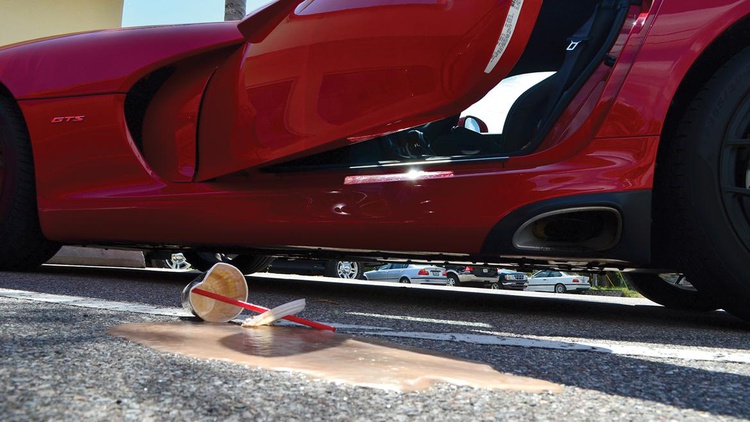First, a ground rule: We’re going to do our best to get through this entire story about a shiny, bright-red Dodge Viper GTS without a single use of the word “douchebag.” Starting now.
In fact, we recommend abandoning all your negative beliefs about Viper ownership immediately. While there may be some truth to the stereotypes, for the purposes of this exercise let’s …
Life Far From the Edge
First disclaimer: This is not a track test of the Dodge Viper. And before you scream at us that we’ve wussed out, please open the February 2014 edition of GRM for a complete track review of this car. No, this is about real life, and real life rarely visits the race track. Real life is full of trips to the grocery store, humdrum errands, drive-thru windows, high curbs and low-attention-span drivers. Taking a Viper to a race track is easy. We know it excels between the apexes and the braking points. But how would it do between the Applebee’s and the Barnes & Noble?
Acquisition

For us, acquiring a Viper was easy. Well, relatively speaking. Press fleets usually have lots more Grand Caravans than exotic sports cars, so scheduling a week with a Viper involved some extra complexity. And when a journalist borrowing the car before us had a run-in with a curb–perhaps a testament to the fact that self-restraint is one of the most important requirements of supercar stewardship– our weeklong slot got pushed back while a new wheel was sourced.
But once it showed, the handover was barely more ceremonious than if it had been a Camry or Accord. The drop-off happened at our home instead of at the office, sure, but everything else was standard. Keys, signature, quick rundown of a few buttons, and “Have a nice day, sir.”
Once the attendant from the media motor pool cleared the area, though, something unusual happened. We immediately became acquainted with several neighbors who never thought to walk across the street when a Hyundai Elantra was in the driveway.
Early Verdict

We’ll cut to the chase a bit, because the purely objective part of our query was answered rather quickly. Can you drive a supercar every day? Absolutely. Technology has progressed to the point where reliability is barely an issue anymore, and driving even the most powerful car–like this 640-horsepower monster–is so easy even a journalist can do it.

The biggest day-to-day physical hassle is pure ingress and egress. The Viper’s wide sills–hiding red-hot exhaust pipes–require a rather ungraceful exit. The real irony is that the people who have lived long enough to afford such a machine are the ones who will have the biggest trouble getting in and out.
Say what you will about the Viper’s styling–you can call it impractical or overdone or audacious if you want–but there’s no denying that the shape oozes energy. There’s also no denying that the C-word will come up in any Viper discussion with people even somewhat knowledgeable about cars. And while it’s hard to discuss the Viper without discussing the Corvette, the real story is about their differences rather than their similarities.
Both are world-class sports cars, but they get there in very different ways. The Viper is Malcom X to the Vette’s MLK. Magneto to its Professor Xavier. They have similar goals, but one doesn’t care how many kneecaps it has to break to achieve them.
And people seem to understand that on a primal level. The last Corvette we had got some attention on the road–a few smiles and nods–but driving a Viper is a whole other level of stepping into a fishbowl. Cars cut across three lanes of traffic on the highway to get a closer look. It seemed like a camera was pressed to a window in half the cars we encountered on the road. Kids smiled and waved. Attractive women looked profoundly disappointed, yet still somehow intrigued, when they saw who was driving. Most of all, people reacted. The first lesson we learned about driving a supercar every day is that everywhere you go, it’s an event.

“How much?” and “How fast?” were common questions, but just as common were personal anecdotes. A guy at Lowe’s started a conversation that culminated in him getting a little misty reminiscing about the TVR Griffith he had when he lived in Ireland. “The Lucas electrics meant you could only have lights or wipers, but never both. So we’d just turn the lights on and try to drive fast enough to blow the rain right off the windshield.”

He related this story while we were packing 60 feet of ¾-inch PVC, a lawn pump, and various fittings into the $120,000-plus exotic sports car. He seemed unfazed by our resourcefulness, or by the fact that we could easily get the 5-foot sections of PVC into the car and close the hatch, proving conclusively that a Viper can assist you in multiple forms of laying pipe.
Day In, Day Out

For a solid week, we drove the Viper every day, acting as though it were our only car. It’s doable. As our week neared its end, we realized that the pressure doesn’t come from the actual logistics. With its big hatch and deep trunk, the Viper easily swallows a couple hundred bucks’ worth of groceries.
Nor does it come from any inherent finickiness or complexity in the machinery. Most Viper owners report that well-maintained cars are reliable and drivable. Several consumable parts are shared with other cars in the Chrysler lineup, and even at 640 horsepower—a figure so high that Viper race cars are detuned up to 20 percent to compete in some pro series—the 8.4-liter V10 is still rather understressed.

No, the real burden of the everyday supercar is the emotional one, and we think this is where so many supercar owners either fail or miss the mark altogether, earning themselves the scarlet “DB” in return.
See, we met a lot of people when we were driving the Viper. It’s impossible not to. Kids, adults, car people, non-car people, old ladies, bikers, cyclists, priests, rabbis–no one could walk or drive past the Viper without reacting. Some simply waved or took a picture, but some stopped and engaged with us, telling us stories like the TVR guy, asking us questions, taking pictures (we got very good at using the camera controls on every major smartphone), and generally just wanting to bask in the Viper’s radiating heat.
So the real question is not “Can you drive a supercar every day?” but rather “Can you handle the burden of driving a supercar every day?”
For most modern cars–even hyperexotics– they’re going to start, run and drive every day. But driving them means that you are now an ambassador for the concept of cars being more than just appliances.
And here’s the thing: This doesn’t just apply to supercar. We bet any of you with a really clean first-gen CRX get a few questions from time to time. Or anyone with an autocross trailer loaded with tires and tools. You’re the connection between a world where cars are fun, and the world where they’re not. If you drive a Viper every day, but can’t stand that people are always asking you about it, then you’ve earned your douchebag title. Yeah, we said it.
Driving a supercar–or any other attention- grabbing ride–comes with the burden, or rather the responsibility, to spread the message that cars can be fun, exciting, sexy, frivolous and entertaining, and that’s totally okay. There’s nothing wrong or antisocial about it.
Most of our week with the Viper taught us that extreme machines have the power to stir emotions in just about everyone. It’s our job to make sure those emotions are nurtured in a positive direction. In other words, driving a Viper does not make you a douchebag. Being a douchebag makes you a douchebag.
















